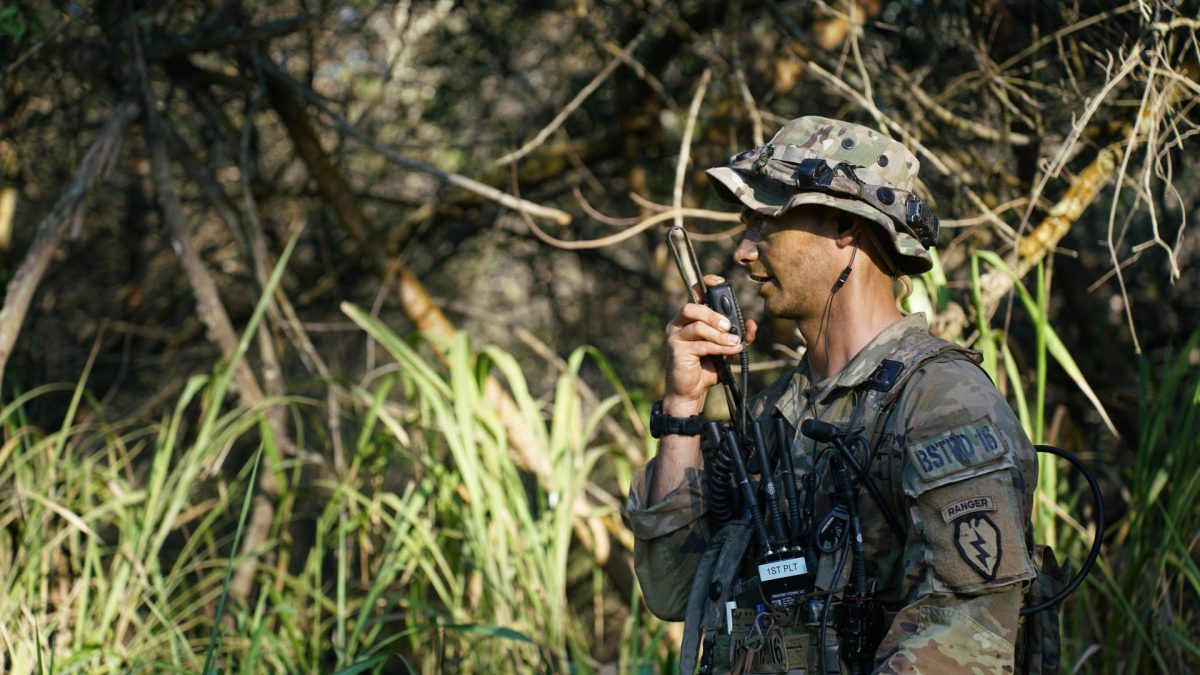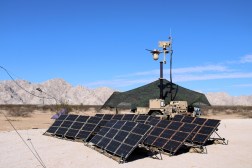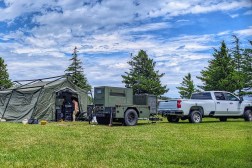Army developing next generation of command and control for all units, echelons

PHILADELPHIA — The Army has reached an inflection point as it continues to modernize its network.
This journey began around six years ago to provide units with modernized kit on a predictable two-year cycle, and in the last three years the service sought to unify the tactical and enterprise networks into a single, global unified network.
Observations in Ukraine are forcing changes all across the Army to include the network, such as smaller and more mobile systems to allow forces to move faster on the battlefield. However, as the service marched down its modernization path, there became haves and have-nots. Some units were equipped with newer gear, with the intent to tier fielding of better equipment to the whole Army at some point down the line.
These two-year capability sets — each building upon the previous delivery for the integrated tactical network made up of commercial off-the-shelf and program-of-record equipment — are going away in favor of a more iterative process to update certain capabilities when technology matures. But in the interim, the Army has sought a more holistic approach to modernizing the total active force with equipment that makes it more lethal on the battlefield.
To get to the next generation of command and control, the Army is first embarking on what it dubs “C2 fix,” which involves essentially taking the entirety of the network portfolio and distilling it to the basics of what a maneuver commander needs.
“The primary goal of C2 fix was how do we simplify the infrastructure that’s already in these formations so that they could better operate their network and better rely on some of the staff functions that are network enabled — think sustainment, intelligence, fires — how those network enabled functions are task organized or organically employed within the formation,” Mark Kitz, program executive officer for Command, Control, Communications-Tactical, said in an interview at the Army’s Technical Exchange Meeting in Philadelphia this week. “Really simplifying the formation, which then led to a much more simple implementation of the network, how they employ [primary, alternate, contingency and emergency communications], how they get after their command post … how they were able to get a much more lightweight and mobile capability by moving a lot of those functions to the division and then building a network then to enable the division.”
During the counterinsurgency fight of the last 20 years, the brigade was the primary unit of action. Now, as the Army plans for large-scale combat operations against sophisticated nation-states, the division must now be that main unit of action given the vast distances of operations and complex problems those actors will pose.
The integrated tactical network was very brigade focused and thus forced the Army to adjust its approach. Given that a large portion of the Army does not have updated, modernized ITN gear as it only comprises about 15 percent of the service, C2 fix begins to look at ITN and non-ITN units and how they all will command and control on the battlefield.
C2 fix is “also giving commanders flexibility, division commanders, flexibility to employ a much more robust capability, rather than organically employ it at every brigade,” Kitz said.
Divisions have several enabling units from intelligence to sustainment that will be essential in large-scale combat operations, but weren’t necessarily the focus of the ITN build and thus also require modernized kit.
Recently, 2nd Brigade of the 101st Airborne Division participated in a home-station training event dubbed Operation Lethal Eagle, a large-scale air assault that provided the opportunity to test new technologies, prototype reorganized structures and employ multi-domain fires.
“We have a lot of lessons learned and I think you heard some of the positives today: mobile command posts, lightweight, much more simple to employ,” Kitz said. “I think some of the other areas where we have to improve is how is the division then employed to support the brigade? How does a division employ to support disparate brigades? How does an armored unit that’s maybe not ITN enabled interoperate with a C2 fix or an updated C2 formation?”
That event is part of Chief of Staff Gen. Randy George’s concept known as “transforming in contact,” which sees the Army using deployments and troop rotations to test new equipment — mainly commercial off-the-shelf gear — to allow units to be more responsive on a dynamic battlefield. The 2nd Brigade of the 101st Airborne Division is the first mobile brigade combat team in the Army, serving as a test unit for transforming in contact.
“We are learning new fires architectures, we’re learning how intel data can support the commander, we’re learning how we can employ PACE in a much more simple, much more lightweight way. I think we’re really, no kidding, doing this transforming in contact as we go through this [Joint Readiness Training Center] rotation,” Kitz said.
C2 next
While the force is focusing on C2 fix for the near term, the Army is also looking further down the road at next-generation capabilities dubbed “C2 next.”
This week, George signed out a “characterization of needs” for C2 next.
As the Army continues to modernize, he said it is going to look at requirements differently and buy differently.
“We’re not going to buy the same equipment. We may buy something for this brigade, it’s going to be modular, open system architecture … [1st Brigade, 25th Infantry Division] might get something or [3rd Brigade, 25th Infantry Division] might get something completely different the next year. It’ll be compatible, it’ll be open system architecture, but it’s going to be the best thing that’s on the market. That’s what we owe our troops,” he said at the Technical Exchange Meeting.
The Army wants to change its contracting process, looking for more flexible mechanisms to buy the latest and greatest when it’s available and quickly insert it into units.
“Even if we build something brand new today, even the chief just talked about C2 next, today’s version of C2 next is not what we’re going to fight with three years from now. Iterating our requirements and getting much more volatile in how we get after capability is critical to the programmatics,” Kitz told conference attendees. “One of the fallacies I think in the past is we’ve bought serial number number one, serial number number 100, and they were the same thing and nine years elapsed. We need to get out of that type of business. We’ve got to iterate more volatile and with a requirement process that’s integrated between Army Futures Command and the ASAALT community.” ASAALT is an acronym that refers to the office of the assistant secretary of the Army for acquisition, logistics and technology.
George envisions an end state in which units are using tablets as mission command platforms rather than the legacy vehicle-based systems that require large trucks for multiple battlefield functions.
“One of the things that I challenged everybody a year ago, and especially AFC, was saying ‘Hey, I want to be able to be on the network and I want us to be able to operate with tablets, phones, software defined radios, very simple architecture,’” he said.
While visiting units at Project Convergence in March, George said he witnessed a platoon leader talking to a company commander, talking to a battalion commander, talking to a brigade commander — all on tablets.
“All those big systems that we used to have, [Advanced Field Artillery Tactical Data System] is one of them, can be an app and it can be on that tablet. So rather than having a truck or two trucks and 10 people, you have an application,” he said.
This is all about making formations more capable and lethal.
“I asked a question to the battalion commander, and he said ‘I want this right now. This makes me more lethal, survivable on the battlefield and that tech exists,’” George said. “Every time that we do something, is this something that the warfighter needs, is this something that’s going to make a company commander, a first sergeant, whoever it is, better to be more lethal on the battlefield? And that’s what we got to be focused on to do it.”
During Project Convergence, 1st Squadron , 4th Cavalry Regiment was provided a set of next-generation capabilities, which provided to be much superior to its existing systems.
As an armored brigade, it had a lot of systems that still date back to the post-9/11 counterinsurgency fight and the legacy Warfighter Information Network-Tactical network.
The new C2 equipment, with very limited training, was intuitive for the soldiers to use, which went all the way down to the private first class level. Troops were able to call for fires and see friendly and enemy forces.
Most importantly, the new capability leveled situational awareness across echelons, said Lt. Col. Michael “Pat” Stallings, commander of 1st Squadron, 4th Cavalry Regiment, meaning all echelons had the same common operational picture.
“What next-generation C2 did really was it leveled the bubbles on that. It allowed the troop and the platoon to see exactly what I was seeing when I was seeing it, to see if there was a collection asset flying, to pull the feeds from that collection asset very easily and intuitively to then use that information to make decisions on what they’re going to do about it. And it was very, very powerful,” he said.
Following the characteristics of need, which is essentially an aim point for industry to focus on, contractors will begin to propose capabilities around a next-generation C2 system.
“I think the biggest area that we talked about today is how do we marry a much more volatile, much more rapid requirement process with our acquisition infrastructure?” Kitz said. “I think in the past, we went after these monolithic software applications or monolithic capabilities that we tried to meld and mold to do things that maybe they weren’t designed to do from the beginning, and now decomposing it and getting after a much more rapid requirement process that allows us to have a much more flexible infrastructure.”






